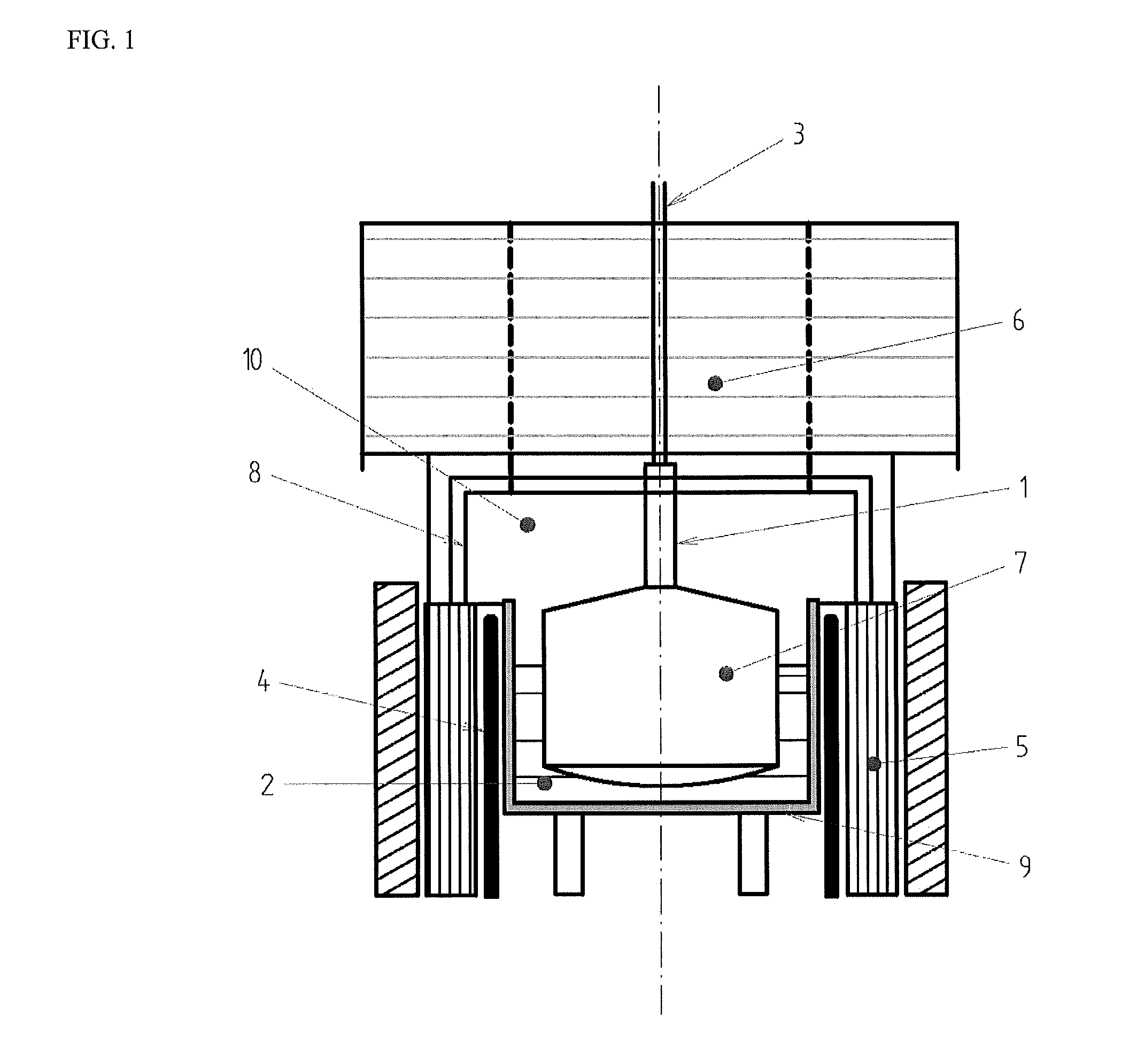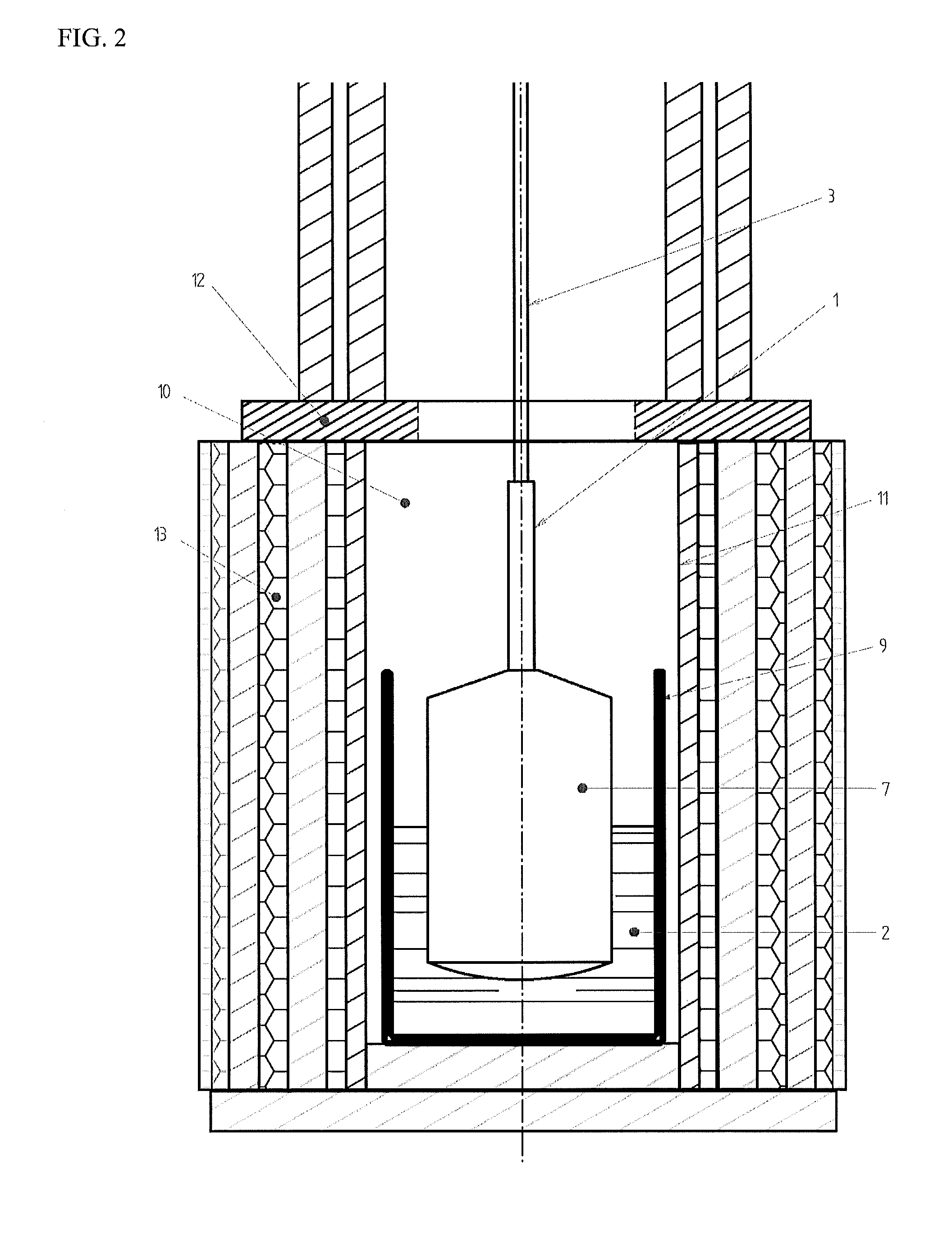Method for the preparation of doped garnet structure single crystals with diameters of up to 500 mm
- Summary
- Abstract
- Description
- Claims
- Application Information
AI Technical Summary
Benefits of technology
Problems solved by technology
Method used
Image
Examples
example 1
[0040]Growing of the Lu3-xPrxAG crystal wherein x=0.002-0.05, in a protective atmosphere of Ar+10 to 40 vol. % of hydrogen in accordance the setup in FIG. 1 (x=molar percent of Pr in the crystal). Growing takes place in a W crucible with the volume of 3 dm3 in a resistance heated furnace heated by tungsten elements 4. The raw material (LuAG, Lu2O3 and Al2O3 sinter) and “praseodymium colorant” (Pr6O11 in the mixture 20 wt % Pr6O11 and 80 wt % Al2O3) is weighed into the crucible 9 in the stoichiometric ratio 29.93 wt % Al2O3+(65.07-69.87) wt % Lu2O3+(0.2-5) wt % Pr6O11. The raw materials are placed in the tungsten crucible 9 which is placed into the tempering zone 10 consisting of W or Mo cylinders 5 and horizontal 6 and cone-shaped reflectors 8, such that the axial temperature gradient within the space containing the crucible and melt is 1° C. / cm. The raw material is melted and homogenized by forced flow of the melt initiated by the difference in temperature between the bottom and to...
example 2
[0041]Growing of the Lu3-xYbxAG crystal wherein x=0.002-0.5, in a protective atmosphere of nitrogen +0.1 vol. % of oxygen in accordance with the setup in FIG. 2 (x=molar percent of ytterbium in the crystal). Growing takes place in an iridium crucible 9 with the volume of 1 dm3 in an induction heated furnace. The sinter (isostatically pressed raw materials LuAG, Lu2O3, Lu2O3 annealed at 1500° C.) and so-called “ytterbium colorant” (a mixture of 50 wt % Yb2O3 and 50 wt % Al2O3 annealed at 1500° C.) are weighed into the crucible in the stoichiometric ratio of 29.93 wt % Al2O3+(20.07-69.87) wt % Lu2O3+(0.2-50) wt % Yb2O3. The raw materials are placed in the iridium crucible 9 which is placed into the tempering zone 10 consisting of ceramic cylinders 11, insulating felt or pellets 13 and horizontal discs 12, such that the axial temperature gradient within the space containing the crucible and melt is 2° C. / cm. The raw material is melted. An oriented seed crystal 1 secured in a holder 3 ...
example 3
[0042]Growing of the Lu3-xYbxAG crystal wherein x=0.002-0.5 in, a protective atmosphere of nitrogen+0.1 vol. % of oxygen in accordance with the setup in FIG. 2 (x=molar percent of Yb in the crystal). Growing takes place in 2 dm3 iridium crucibles in an induction heated furnace. The pulling speed is 0.1-−0.5 mm / hr. The rotation speed is 4 rpm. The raw material (YAG, Al2O3, and Y2O3) and “ytterbium colorant” (a mixture of 50 wt % Yb2O3 and 50 wt % Al2O3) are weighed into the crucible in the stoichiometric ratio of 42.45 wt % Al2O3+(0.2-50) wt % Lu2O3+(7.55-57.55) wt % Yb2O3. The raw material is melted and the crystal pulled on a oriented seed crystal at a speed of 0.1-0.5 mm / hr. Upon achieving the desired weight (depending on the crucible volume wherefrom the crystal is grown), the crystal is lifted via a fast skip by 3 mm and subjected to computer-controlled cooling to room temperature. The result is a colourless YAG Yb single crystal with a flat phase interface and weight of 2 to 7...
PUM
 Login to View More
Login to View More Abstract
Description
Claims
Application Information
 Login to View More
Login to View More - R&D
- Intellectual Property
- Life Sciences
- Materials
- Tech Scout
- Unparalleled Data Quality
- Higher Quality Content
- 60% Fewer Hallucinations
Browse by: Latest US Patents, China's latest patents, Technical Efficacy Thesaurus, Application Domain, Technology Topic, Popular Technical Reports.
© 2025 PatSnap. All rights reserved.Legal|Privacy policy|Modern Slavery Act Transparency Statement|Sitemap|About US| Contact US: help@patsnap.com



